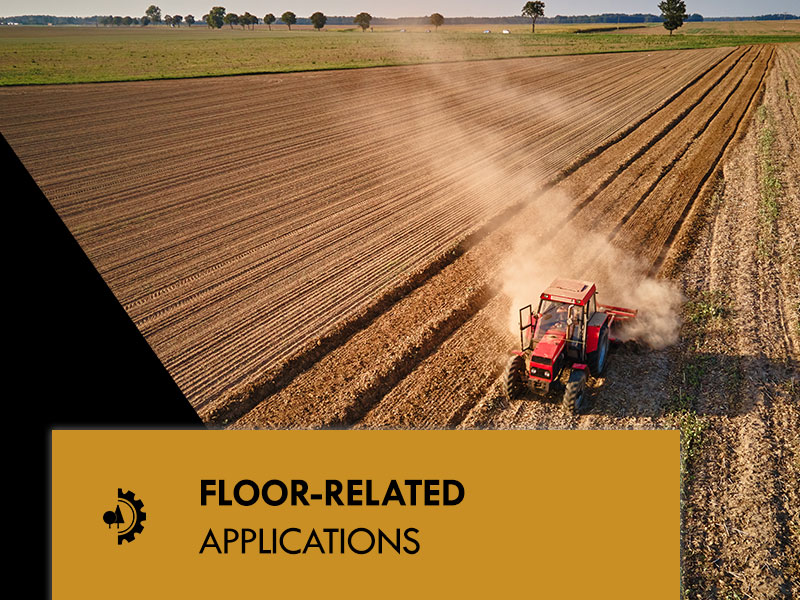BIOCHAR FROM GERMANY
POWER BIOCHAR FROM GERMANY
Biochar: The all-rounder of nature!
Biochar is one of the most important products of our time. It serves as a CO2 reservoir and has positive effects on all environmental media. Carbonisates from pyrolysis of coal have been used for various purposes for centuries — with the CO2 issue, this topic has become highly relevant again. Biochar has the potential to make a significant contribution to combating climate change. With our biochar, we create a carbon sink that stores CO2 permanently for centuries. In addition, we obtain a high-quality and sought-after product.
The term biochar comes from the combination of using biomass and increasing the carbon content through a thermal treatment step, such as pyrolysis. The charcoals thus differ significantly from fossil coal due to the formation process. Biochar has been deliberately produced and used for various purposes for centuries.
Floor
Biochar combines soil improvement and increased soil fertility with the long-term binding of CO₂ and thus the reduction of greenhouse gases in the atmosphere.
Water
Biochar has positive effects on groundwater and bodies of water by reducing the leaching of nutrients and fertilizers into the groundwater.
Atmosphere
Biochar reduces the CO₂ content in the atmosphere by binding carbon, which plants have previously absorbed, in the long term through pyrolysis.
Vegetation
Biochar shows particularly positive effects in soils with insufficient properties for plant growth; the increase in yield is 10% or higher.
Animal world
When using biochar, significantly less antibiotics are used; it also binds moisture and pathogens away from the soil substrate, reducing the impact on the animals.
HOW IS BIOCHAR MADE?
Under Pyrolysis, the thermal decomposition of chemical compounds at high temperatures is understood. In this process, substances are heated up to 1000 °C in the absence of air and oxygen. Compared to gasification or carbonization, less organic substance is destroyed. C-C and C-H bonds of the starting compounds are largely preserved, but in a modified structural composition, meaning that the long-chain and polymer-like molecules are broken down into shorter ones — a bond break is thus generated.
For lignocellulosic biomass, temperatures of at least 250 °C are required to break down the structures. An important factor influencing the biochar produced during pyrolysis and its properties is time.
The properties of the resulting biochar during the pyrolysis process depend on the design of the pyrolysis reactor and the reaction parameters, as well as the biomass and its particle size, shape, structure, and pH value. The key reaction parameters are the temperature or heating rate, residence time in the reactor, catalysts, and pressure.
WHERE IS BIOCHAR USED?
Biochar is an extremely environmentally friendly and promising product, with a rapidly increasing demand. Leading the way is its use as a soil additive, its climate-relevant benefits for CO2 sequestration (capture and storage) of atmospheric carbon dioxide, as a feed additive, in soil and water purification, as well as a nutrient reservoir. The all-rounder of nature.

Biochar in the industry
Industrial applications of biochar
Environmental and Climate Protection
» CO₂ Sequestration: Long-term storage of carbon to reduce greenhouse gases.
» Water and Air Purification: Binding of pollutants in filters for the purification of wastewater or air.
Construction Materials Industry & Materials
» Concrete Additive: Plant-based charcoal improves the stability and thermal insulation of concrete.
» Plastic Industry: Used as a sustainable filler to reduce fossil raw materials.
Energy Generation & Industrial Processes
» Activated Carbon Production: High-quality filter materials for air and water treatment.
» Alternative Fuel: Used as a climate-friendly energy carrier in industrial processes.
Chemistry & Pharmaceutical Industry
» Adsorbents: For binding toxins or pollutants in chemical processes.
» Cosmetics & Medicine: Used in detox products, toothpastes, or remedies.
Packaging & Textile Industry
» Bioplastics: Biochar as a sustainable alternative in packaging materials.
» Odor Absorption: Use in textiles or shoe insoles for odor neutralization.

Biochar in agriculture
Soil-related applications of biochar
Agriculture & Horticulture
» Soil Improvement: Increases water retention and improves soil structure.
» Nutrient Storage: Binds nutrients and releases them slowly to plants.
» pH Regulation: Stabilizes acidic soils and creates better growth conditions.
Forestry & Rewilding
» Reforestation: Supports the growth of saplings on degraded land.
» Soil Remediation: Binds heavy metals and pollutants in contaminated soils.
» Erosion Control: Stabilizes soils on slopes and reduces erosion.
Urban Green & Landscaping
» Green Roofing: Biochar stores water and improves plant growth.
» Parks & Sports Fields: Optimizes soil structure and retains moisture better.
» Street Greening: Reduces drought stress for city trees and plants.
Composting & Circular Economy
» Compost Additive: Accelerates the decomposition process and reduces odor formation.
» Mulch & Ground Cover: Retains moisture and protects the soil from drying out.

Biochar in the animal feed industry
Biochar in animal husbandry
Stall hygiene & bedding
» Odor and moisture control: Reduces ammonia odor and keeps the barn drier.
» Fewer flies & parasites: Creates a healthier barn environment for animals.
» Higher bedding quality: Biochar extends the durability of straw & shavings.
Feed additive for livestock
» Digestive support: Plant charcoal binds toxins and supports gut health.
» Reduced antibiotic use: Strengthens the immune system and reduces diseases.
» Better feed conversion: Increases nutrient absorption and improves growth.
Manure and Compost Processing
» Nutrient Storage: Biochar binds nitrogen and prevents nutrient losses.
» Less Emissions: Reduces methane and ammonia emissions from the manure.
» Better Soil Impact: Manure enriched with biochar improves soil fertility.
» Better Feed Utilization: Increases nutrient absorption and improves growth.
Animal Health & Well-being
» Stress Reduction: Calmer behavior through a healthier barn climate.
» Fewer Hoof & Skin Problems: Dry bedding reduces infection risks.
» Natural Detoxification: Plant charcoal can be used for digestive disorders.
» Better Soil Effect: Manure enriched with plant charcoal improves soil fertility.
» Better Feed Efficiency: Increases nutrient absorption and improves growth.
WHAT ARE THE BENEFITS OF BIOCHAR?

Sustainable Urban and Community Development
➥ Climate Protection and Urban Greening: Biochar permanently binds CO₂ and improves soil quality, e.g., in city trees and green spaces. It increases water retention capacity and reduces nutrient leaching, which is especially relevant in urban sponge city concepts or when greening sealed surfaces.

Forestry & agricultural enterprises
➥ Soil improvement: Biochar loosens soils, increases water retention capacity, and promotes root growth. It acts as a nutrient carrier and reduces nitrous oxide emissions as well as nitrate leaching.

Efficient Reclamation and Soil Remediation
➥ Soil Remediation: On contaminated or degraded areas, biochar binds heavy metals and improves soil structure. It is often used in the restoration of soils after industrial use.

Renovation of conversion areas
➥ Sustainable use: Former military sites or industrial wastelands can be reclaimed with biochar, as it binds heavy metals and prepares the soil for new vegetation.

Industrial Prospects
➥ Construction materials and filter materials: Plant charcoal is used in the construction industry as an additive for insulating materials or in road construction. It is also suitable as a filter material for water and air purification systems.

Fertilizer Manufacturer
➥ Efficient Nutrient Carriers: Biochar is used as a carrier for organic and mineral fertilizers. It enhances the fertilizing effect by storing and slowly releasing nutrients.

